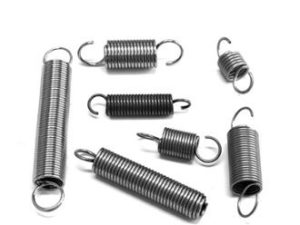 Extension springs are meant to deliver extended force and provide resistance when a load pulls them. They can be large or small, or heavy or light duty, varying in size, diameters, thickness, and materials. And, their ends and hooks can be created with a multitude of configuration variations.
Extension springs are meant to deliver extended force and provide resistance when a load pulls them. They can be large or small, or heavy or light duty, varying in size, diameters, thickness, and materials. And, their ends and hooks can be created with a multitude of configuration variations.
It’s clear, then, that depending on your application, the extension spring design you create needs to be great—your design must be created with precision, quality, and durability. More importantly, it must work for your particular product’s specifications so it can meet and exceed your company’s needs. Here’s how to find a great extension spring design regardless of your application or specifications.
Find a Great Manufacturer
The first step to finding a great extension spring design is to find a great manufacturer. It’s important to find a supplier who will work with you during the design stage of the process. A manufacturer who has professional spring engineers on staff will have the expertise and experience needed to give you advice and recommendations based on your product needs. The supplier’s expertise can guarantee that the extension spring you get functions at top efficiency. Additionally, a supplier who excels at customer service will give you the time and effort you deserve.
Think Your Design Through
Many factors will go into your extension spring design. So, it’s vital that you think these factors through before you get your design custom produced. For example, for most application, simple hooks are more than likely all you will need. What’s more, if your configurations are too complex, you might not be able to find a manufacturer who can produce it or the design will become more expensive to produce than it needs to be for the application.
Your design will depend on the purpose of your spring and how much tension and force it will need. Additionally, you must figure out which type of hook will serve your needs best—do you need hooks coming off the spring, crossover hooks, double loops, or side hooks? You’ll also need to figure out where your spring will be located in your product: Will it need to fit over a rod or shaft or into a hole, or will it need to be in a fixed space? Your application will also make a difference in the type of wire you choose—does it need to be heavy duty or be able to withstand extreme conditions? For example, stainless steel is best if the spring will be in contact with water. Not all wires are meant for all temperatures, applications, or products, so you must choose wisely.
All of these factors will determine the spring length, hook length, inner diameter, and outer diameter of your extension spring design. Knowing the answers to these questions ahead of time will allow you to design the best extension spring for your purpose at the lowest cost possible.
Get a Prototype
Once your design has been created and reviewed by your spring manufacturer, it’s time to get a prototype created. With a prototype, you are able to see and feel your design once it’s come to life. You’ll be able to test out your custom extension spring in the intended equipment and see if it’s a perfect fit. If not, this is the perfect opportunity for you to go back to the drawing board and reconfigure some of your spring calculations with the help of the manufacturer’s engineer. Although some designs are excellent in theory, sometimes the end result doesn’t quite work as intended. It’s important to be able to get a prototype created and tested so you can make adjustments if needed before mass production begins.
Worm Wire
Learn How Our Spring Design Helped Save an Automotive Company $100K+
